minute read
Today’s sales reps need the right resources to nurture leads and win over prospects.
55% of B2B buyers now rely more on content to inform their purchase decisions than in previous years. As prospects navigate their options, they are seeking (and expecting) compelling, informative content to guide their purchasing decisions.
So how do we cater to these evolving preferences in 2024? Enter sales enablement materials — also known as sales collateral.
Sales collateral is one of the most important weapons in a sales team’s arsenal. It gives reps accessible assets for closing deals, and prospects a more personalized and informed buying experience – a win-win for everyone involved.
This guide will walk you through some of the most effective types of sales collateral you can have in your toolbox, and how and why you should be using them in your sales process.
Sales collateral is any type of content, either printed or digital, that helps the sales team move prospects, leads, or customers down the sales funnel. It’s essentially educational material that informs the buyer according to where they are in their journey toward making a purchase.
There are several different types of sales collateral, and each piece should be tailored to your target audience and for each stage of the buyer’s journey. From blogs and white papers that raise awareness at the top of your funnel, to case studies and customer success stories that provide detailed illustrations of how your product can be used to solve real-world problems – a diverse mix of sales collateral will ensure sales reps have everything they need to close more deals.
Prospects have different needs, questions, and concerns as they make their way through each stage of the buyer’s journey – from awareness and consideration to decision and delight.
Each type of sales material should be made and used with these stages in mind. Even the most well-crafted asset will fail to convert if it lacks relevance and usefulness for your prospects or customers at their respective stages.
Let’s dive into 21 different types of sales collateral, broken down by each stage of the buyer's journey and how your sales teams can use each one.

Your prospects begin their path toward purchase by first becoming aware of a problem they need to solve. Sales reps are responsible for further educating their prospects about their problems and possible solutions. In this stage, it’s important to build a foundation of trust. The following sales materials can help build that foundation.
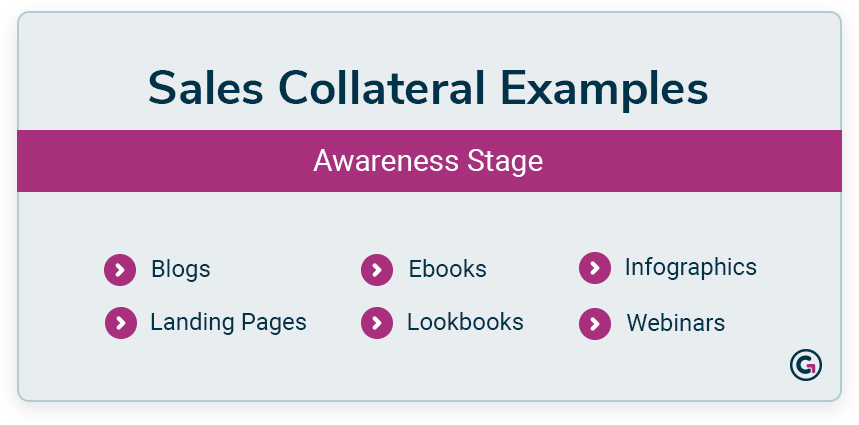
Blogs can and should be used by the sales team as sales collateral. Typically, marketers get their blog content from their sales reps. This content is driven by the most frequently asked questions from prospects. And who best knows those questions? The sales team.
So it makes sense that the sales department should use these posts as they aim to answer and educate their prospects or customers. They can be used in email outreach, cold calling, or even in follow-ups. By educating prospects and leads with this content, brands form an automatic connection of trust.
At GoDelta, we have our own comprehensive learning center that answers the questions our prospects ask. Here, you can find everything you need to know about branded merchandise, digital marketing, sales enablement, and employee recognition. This content is used to fuel our sales team as they talk and engage with potential customers.
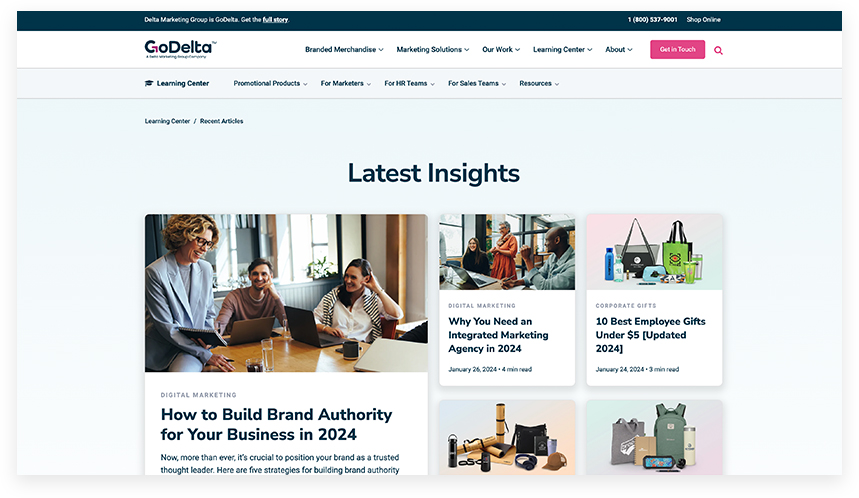
Similar to blogs, eBooks are used to inform customers in the awareness stage. These are comprehensive digital books that delve deep into a specific subject matter. eBooks can be used by sales reps to educate prospects about complex topics, showcase thought leadership, and nurture leads.
Since this type of sales collateral is more comprehensive, it is often gated and used as a lead-generation tool. Gating means shielding an eBook or other piece of content behind a form where your prospects have to exchange a piece of information (usually their name and email) in order to download your content.
Here’s an example of an eBook in action. Let’s say a prospect wants to learn more about buyer personas. They search Google and stumble upon this helpful resource. They enter their email, download the eBook, and spend the next day or two educating themselves. Now, when the sales rep follows up, they’re in a stronger position to close the deal, given the buyer's higher level of education.
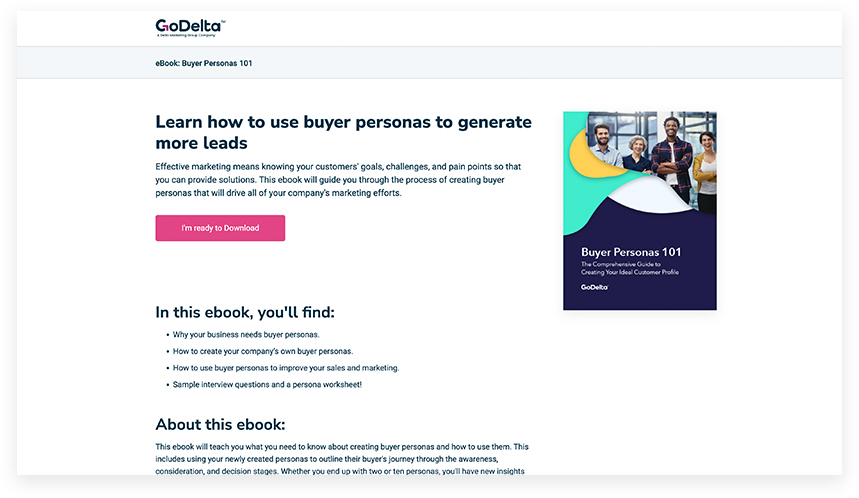
Because it’s an event, webinars are not often thought of as sales collateral, but they’re a great way to introduce prospects to your brand and attract customers in the awareness stage. It’s also another way to paint sales reps as authority figures in their industry.
Webinars are more than just a moment-in-time type of sales collateral. On-demand libraries can be created to display past events for prospects to download or watch at their convenience. Salespeople can then easily point their prospects toward a certain recording or episode that directly relates to a question or concern they might have.
Here’s an example of a webinar library from Resonance Global, a global consulting firm focused on cross-sector collaboration.
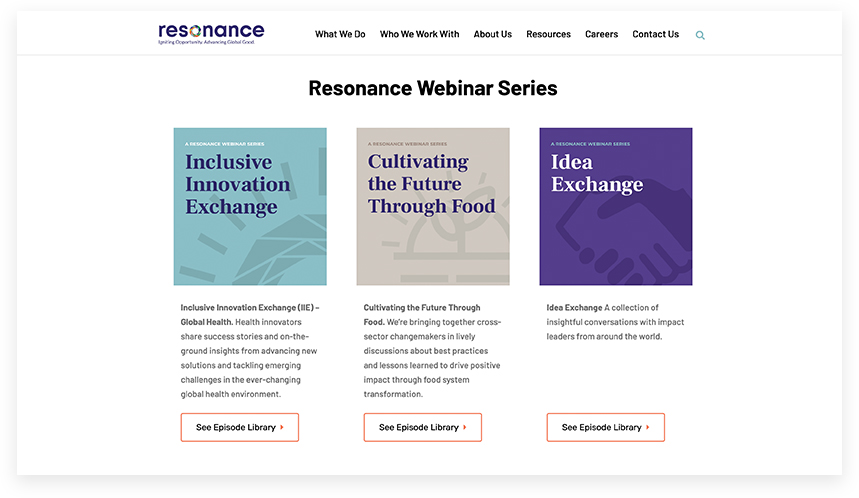
Landing pages serve as standalone pages designed to convert visitors into qualified leads. Sales reps can guide prospects to landing pages with specific calls-to-action (CTAs), like scheduling a demo or downloading a whitepaper.
Consider landing pages that prompt visitors to request a quote. Users fill out the form, providing their contact information, pertinent details about the services they seek, and the challenges they’re encountering. As a result, sales reps gain valuable insights into prospects even before initiating direct communication. Armed with this knowledge, reps are better equipped to understand the prospect's pain points and offer tailored solutions.
Here’s an example of a landing page for IT service provider Meridian Imaging Solutions. Notice how the landing page includes digestible information about the service and includes social proof from satisfied customers. This adds authenticity and makes it more likely that customers will trust the sales rep who reaches out.
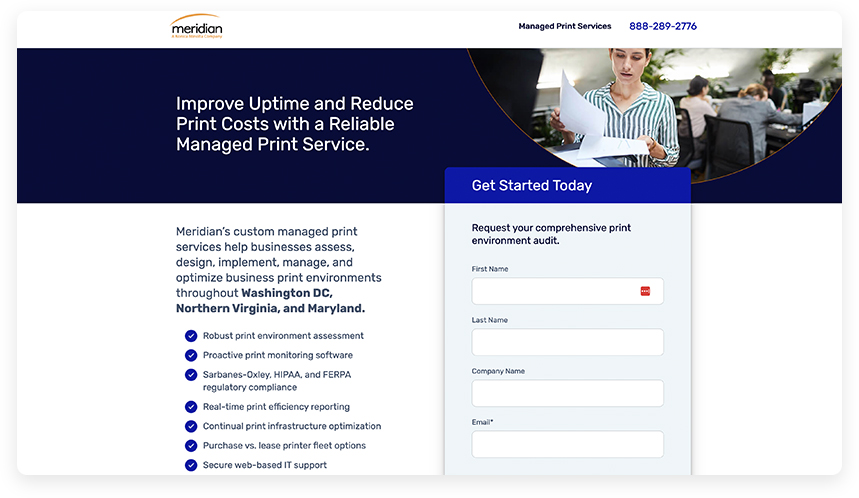
Infographics are visual representations or illustrations of key information or data. Typically, they are used to simplify a complex idea or process. Instead of data dumping customers or prospects, sales reps can share infographics with their customers addressing specific processes they might have questions about. Prospects or customers can then take this information with them and use it to fuel their journey through the buyer’s journey.
The best infographics often center around data. Facts are the easiest way to sway prospects, and that’s what they are most interested in. Infographics can help present the facts in an easy-to-understand way. Since 65% of people are visual learners, buyers will certainly appreciate and benefit from this added resource.
Here’s an example of an infographic from the 2023 ASI Ad Impressions study that breaks down average promotional product impressions. Notice how it makes each individual data point eye-catching and easy to look at. The graphic is designed so readers are drawn to key data points, with text kept to a minimum.
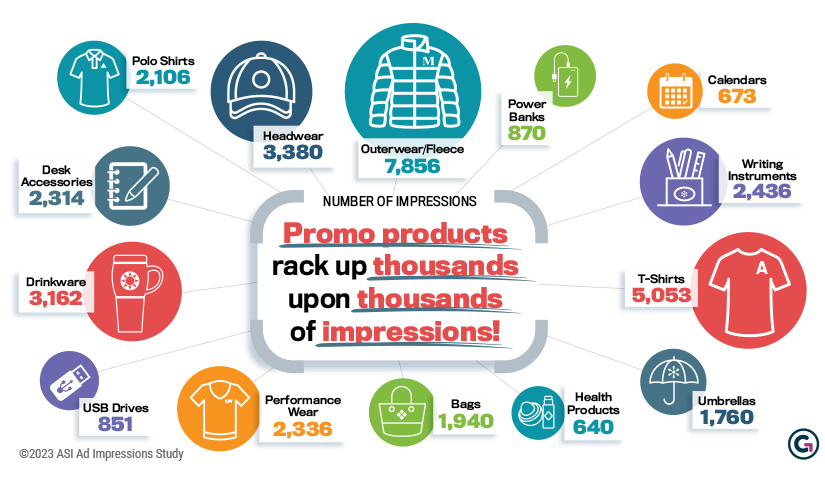
Lookbooks might not be suited for every industry, but are useful sales tools for businesses with more visual and/or aesthetic-based products or services. This type of sales collateral is still used in the awareness stage, so typically you want to stay away from cost and price.
A compelling lookbook will ignite excitement in your customers, stimulating their imagination as they start to envision their own ideas. It will show how much potential there is for them to partner with you, and invest in what you have to offer.
Here’s an example of a lookbook we created for Trowel Trades Supply, a masonry supply company. Notice how there are no prices listed. The resource uses lifestyle imagery and text to tell a story and establish a pleasing aesthetic to encourage prospects to take further action.
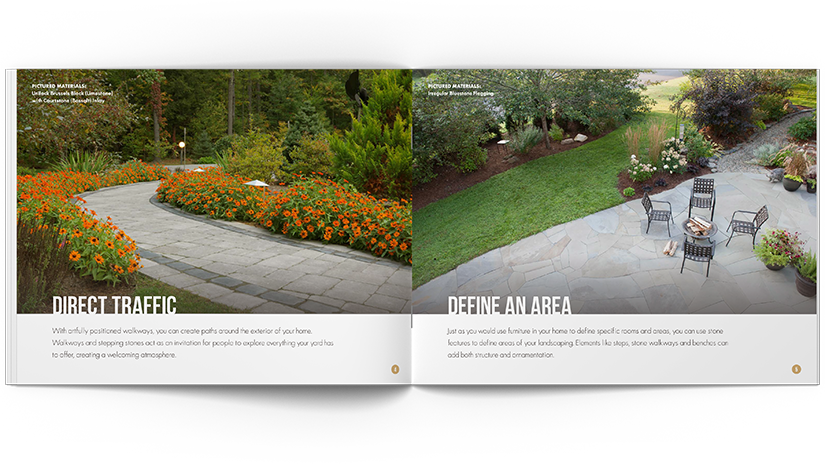
In the consideration stage, prospects have clearly defined their problem, and are researching solutions. They might be considering your products or services, but they are also looking at alternatives.
Prospects are more educated than ever before and thus more skeptical. Competition is high, as buyers weigh options more carefully and seek out reviews and comparisons more readily. So it’s crucial sales teams have middle-of-funnel content to convince skeptical buyers of the value of their solutions. Your consideration stage collateral should articulate the value of your products/services and illustrate how they will ease your buyers’ pain points.
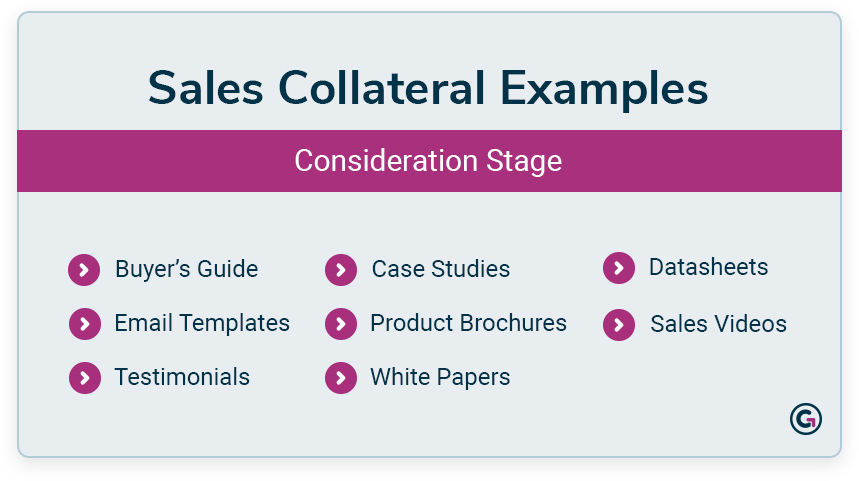
White papers are long-form, in-depth pieces of content that offer technical information targeted to your buyer persona. The idea is to paint your company as a thought leader on a particular topic relevant to your industry.
When reps leverage this type of sales collateral, they make decision-makers feel more confident. Remember, buyers like to feel they did their due diligence before committing to a purchase. White papers can help them feel educated and empowered, while still swaying them towards your products or services.
Here are some quick tips for creating a high-quality white paper:
Here’s an example of a white paper from Konica Minolta, an industry-leading technology company. Note the clear structure with defined subheadings. Each section is dense but digestible, providing in-depth research, unique insights, and paragraphs packed with facts and recent data.
Testimonials should be short, sweet, and to the point. They’re typically quotes (1-2 sentences) from satisfied customers and are especially helpful for prospects who might not have time to dive into a whole case study.
Sales reps can share testimonials to build credibility and reassure skeptical prospects about the quality of business offerings. When prospects see other people who had the same concerns explain their stories and why they were satisfied, it increases the likelihood of them believing that your product/service is the optimal choice.
We love testimonials at GoDelta and sprinkle them on service pages, landing pages, and case studies. Here’s an example of a testimonial from a satisfied client who needed virtual event swag boxes. Notice how the quote expresses strong positive emotions and appreciation. This language suggests excellent customer service, which potential customers will appreciate.
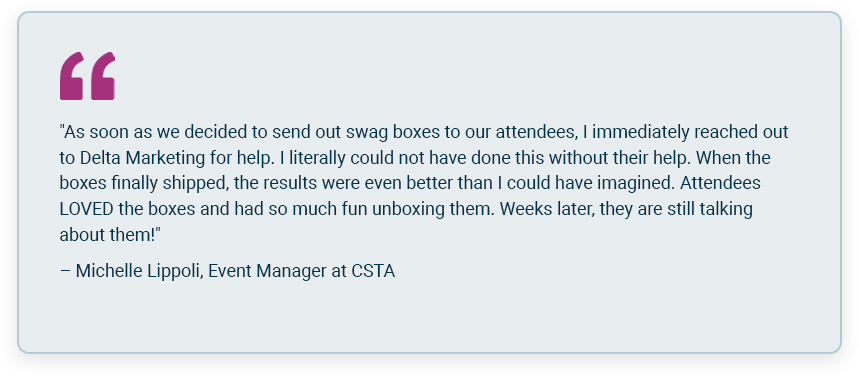
Case studies are basically extended testimonials. They tell a persuasive story of how your product or services helped another client. The best case studies follow a repeatable format, making it easy for the buyer to read and find the success story you're trying to get across.
Case studies often follow a structured format that includes the following elements:
Here’s an example of a case study we created for one of our digital marketing clients. It includes a quote from the company’s president, the challenges they faced before using us, the solutions we proposed and delivered, and the measurable impact of our services. Our sales team uses this piece of sales collateral to show prospects what we’re capable of and the kind of success clients achieve when they partner with us.
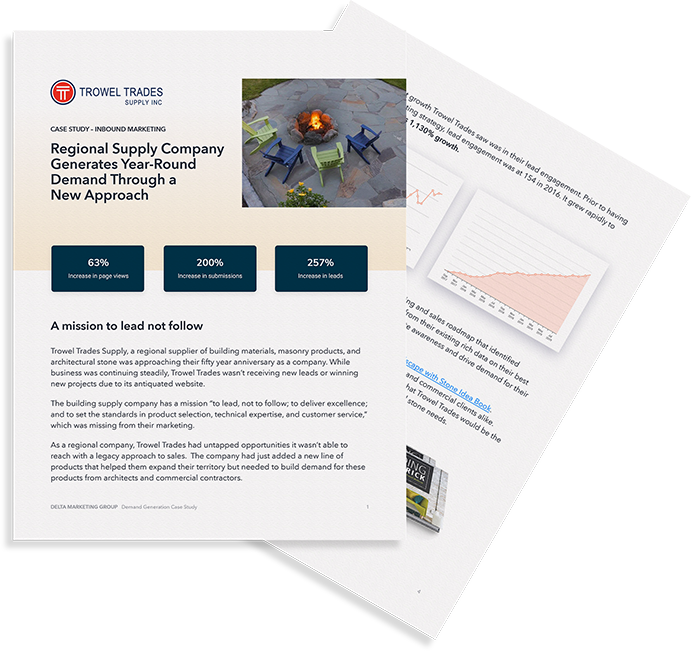
A buyer's guide, also known as a buying guide, helps consumers understand what to look for and consider when buying a specific type of product or service. The best buyer's guides often include comparisons between different brands or models, highlighting their pros and cons. This is a great way to show, not tell, customers why they should choose you over someone else.
Here are some other key elements of buying guides:
Here’s an example of a buyer’s guide for multifunction printers (MFPs). This guide goes into depth about what an MFP is, the benefits, the different types, and key features to look for. It also includes details about different models so readers can make an informed decision on which machine best fits their needs.
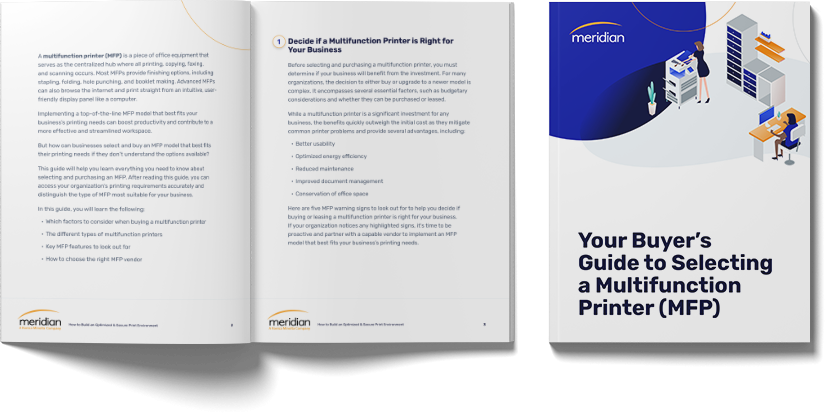
Product brochures are branded documents that highlight key product features and benefits. Brochures often include high-quality images, compelling copy, and a clear call-to-action. They can come in various formats, such as bi-fold, tri-fold, or booklet forms, and can be distributed physically or digitally.
Sales reps can mail printed brochures to potential clients as part of a direct mail campaign or share digital versions via email or on social media. They’re also typically used at trade shows or in-person conferences as leave-behinds for interested attendees.
Here’s an example of a product brochure for our client Flexaseal, a leading provider of industrial sealing technology. Notice how this multipage document includes a brief history of the company that establishes context, before launching into the details of their products and services. A glossary of industry-specific terms is included to further educate the prospect.
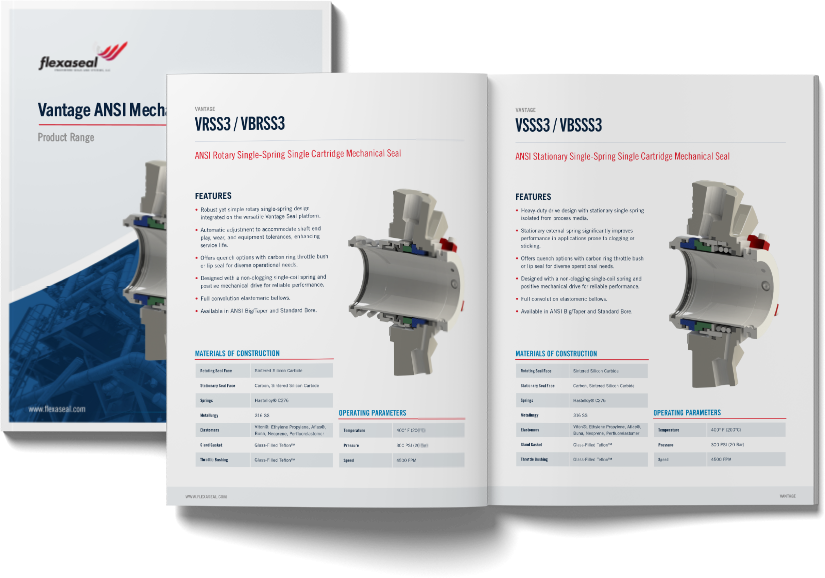
Technical datasheets, also known as product spec sheets, are one-pagers that generally include information like technical specifications, product features, performance metrics, compatibility information, and benefits. Think of a datasheet almost like a more technical flier.
While datasheets are often quite technical, they are invaluable for sales reps selling complex or technical products. They help communicate the product's value proposition clearly and concisely, making it easier for the prospect to understand the product and make an informed purchasing decision.
Here is an example of a datasheet for Flexaseal. Notice how it contains technical information about the product, an image, as well as contact information for the company. The features are listed in a bulleted list, short and to the point.
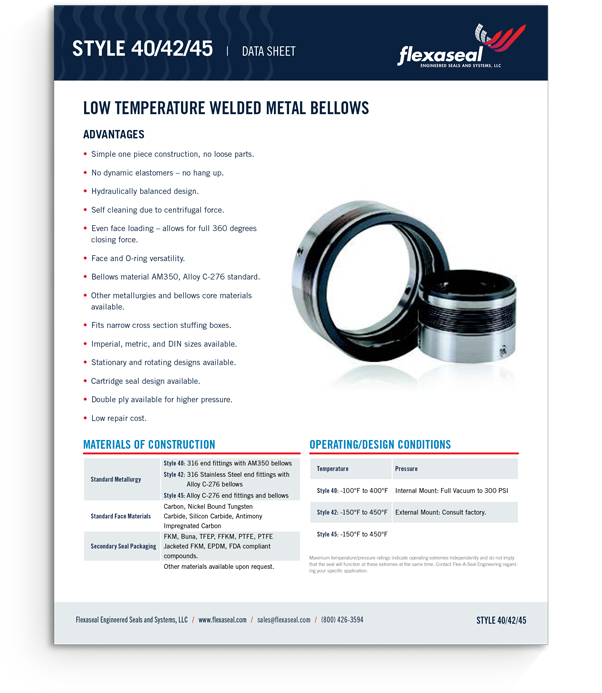
Email templates are a great sales collateral tool for streamlining the sales process and saving valuable time. They can be used at any stage of the buyer's journey but are often most effective when a prospect is still considering their options.
If a prospect is taking some time to make a decision, check-in email templates can help maintain communication and keep the sales rep top-of-mind. It’s also easy to attach other pieces of sales collateral onto these email templates, which is an effective way to build trust and further educate prospects who haven’t committed to your product/services yet.
CRMs like HubSpot offer customizable email templates that allow sales reps to quickly personalize and send emails. Simply write master versions of common outreach emails and save them as templates. Attach marketing collateral such as guides, eBooks, or proposals to educate prospects and highlight the value of your product.
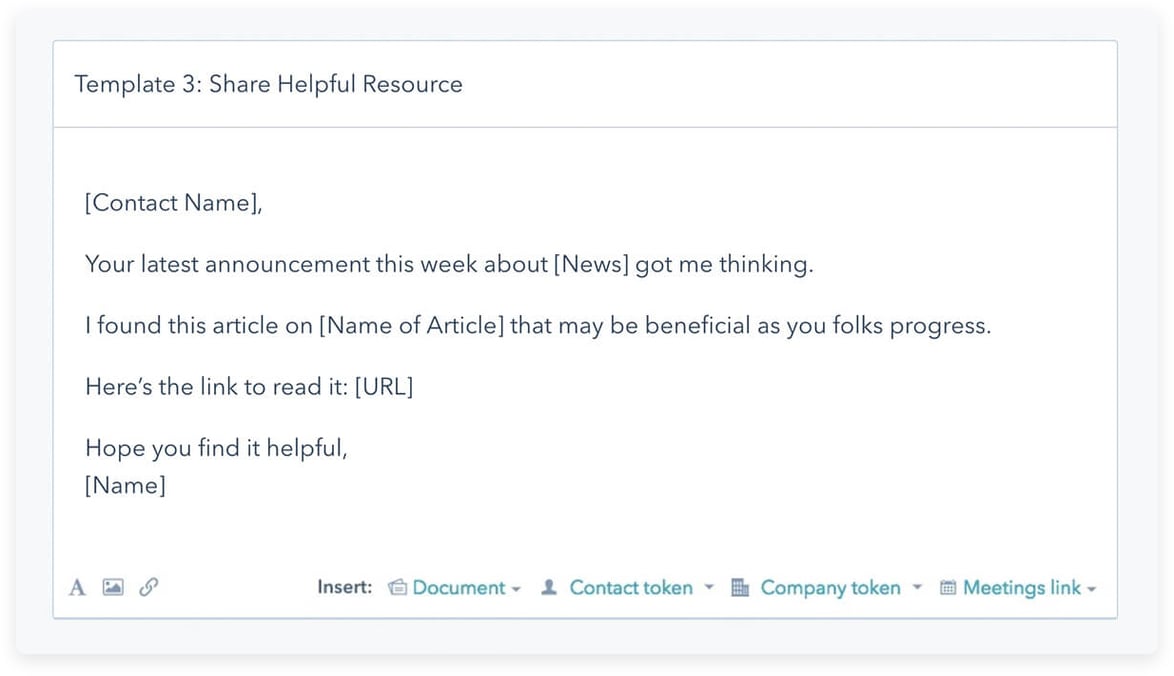
Sales videos are a way to put a face to your brand while humanizing your reps in the process. Product unboxings, explainer videos, or product demos can all be used to explain your products or services in a more visual and helpful way. In fact, sales reps who use video within their emails are reported to see 8 times higher open-to-reply rates. And personalized video has been seen to close more deals and improve customer retention rates.
Below is an example of an effective sales video that highlights key product features and information on how it can be installed. It’s short and informative but still engaging for the viewer.
After considering the options, it’s time for the buyer to make a decision. And it's the sales rep’s job to convince them that your product or service is the best option. Decision stage collateral will drive this point home.
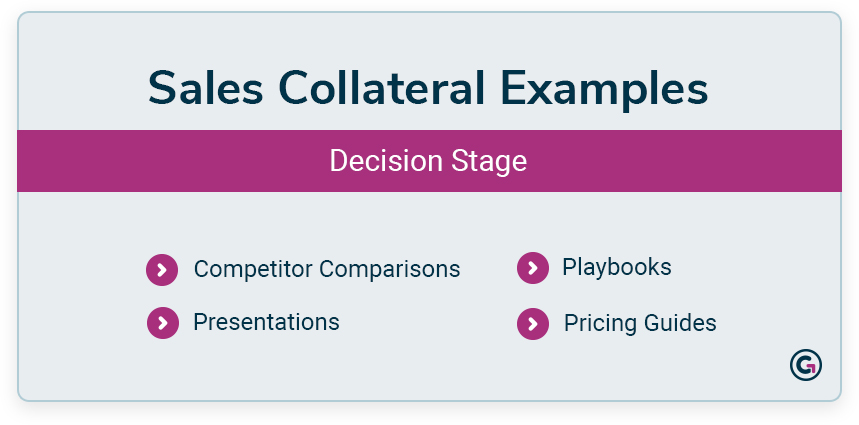
In the digital age, sales presentations are a type of sales asset that offers ample room for experimentation and creativity. Gone are the days of boring PowerPoint presentations or generic slide decks. Interactive virtual presentations are a more interesting way to engage and delight prospects and ultimately win them over.
We love this blog from HubSpot that identifies the best sales presentations out there and walks you through some tips for spicing up your own sales deck.
The decision stage is where price becomes front and center. Ultimately, this is one of the biggest factors in your prospects' decision, so it makes sense to have a clear, to-the-point guide to help reps through the sales process.
An effective pricing guide will be clear and straightforward. Consider putting together tiered bundles to emphasize exactly what each prospect will get for their money. This should help prospects see the value they’ll receive with each package, and make it easier to choose the right one. Here’s a great resource that walks through different formatting and content tips for your pricing page.
You can find examples of pricing guides in action by looking at the pricing pages on various websites. Wistia has an effective pricing guide that you might consider modeling after.
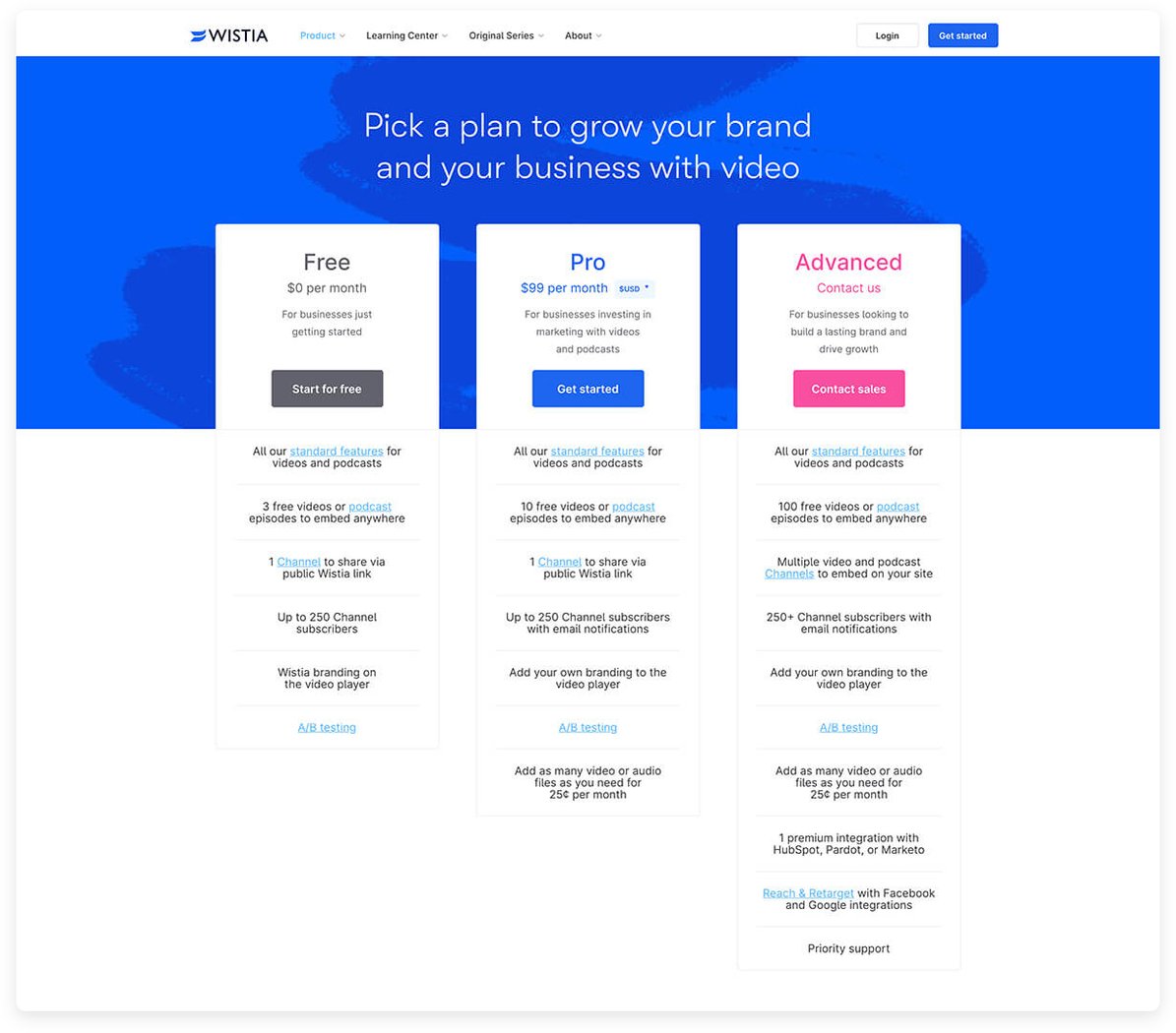
Sales playbooks are strategic documents that provide a detailed guide for salespeople on how to approach, engage, and close deals with prospects. They're essentially a roadmap for success in selling a particular product or service, outlining the best practices, methodologies, tactics, and tools that have proven to be effective. Sales playbooks typically include tutorials, pre-written responses, call scripts, and information on buyer personas.
Every business’s sales playbook will be different, but HubSpot offers a free customizable template to help you get started.
Sometimes referred to as battle cards, competitor comparisons are another piece of sales collateral that can help sales reps overcome objections. Prospects are already comparing your business to your competitors, so why not give them that information upfront? That allows you to be in control of the conversation.
Competitor comparison sheets will typically be a one-page document that shows the difference between you and your competitors. They can be a simple, side-by-side comparison of your company’s main features and selling points compared to your competitors. Sales reps should have easy access to this information and pull this piece of sales collateral out when a prospect references a competitor in a conversation.
Here’s an example using HubSpot’s battle card templates. These sheets should showcase your strong points as a company, but you never want to stretch the truth. If a competitor is better in one area than your company, share that information. Chances are, your prospects will see that level of honesty as a reason to trust you with their business.
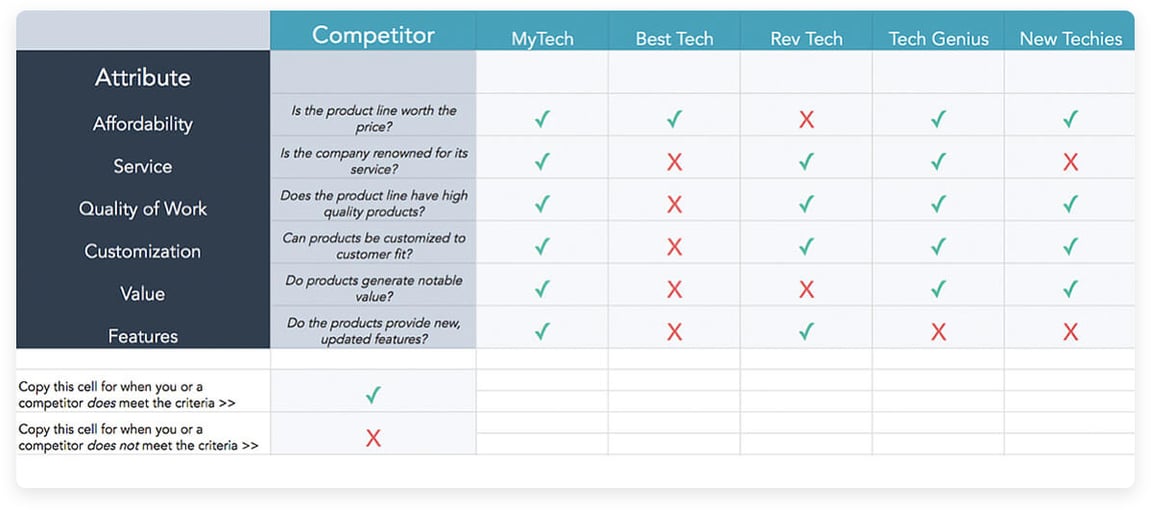
Creating a mix of sales collateral might feel overwhelming. But you don’t have to create every type all at once. Define the most important piece of sales collateral for your business and get started there. Here are a few tips and best practices to get you started.
Need inspiration? Browse our creative portfolio to see how we’ve helped our clients close more deals.
Creating a mix of sales collateral might feel overwhelming. But you don’t have to create every type all at once. Define the most important piece of sales collateral for your business and get started there. Here are a few tips and best practices to get you started.
Need inspiration? Browse our creative portfolio to see how we’ve helped our clients close more deals.
Once you have your mix of sales collateral, it’s time to teach your sales team how to use it. Here are a few tips to get them on board:
Sales collateral is an essential part of connecting with, communicating with, and converting prospects. With today’s buyers more empowered than ever before, investing in your sales teams with great quality collateral is a must if you want to shorten the sales cycle and close deals faster in 2024.
Get in touch if you need assistance creating sales collateral for your business. Our team will help you develop the printed and digital materials needed to engage prospects, convert leads, and grow your business. We can also provide sales enablement training and guidance on how best to use the content so that your sales team is always prepared and ready to hit their targets.
© 2024 Delta Marketing Group, All Rights Reserved. South Burlington, VT